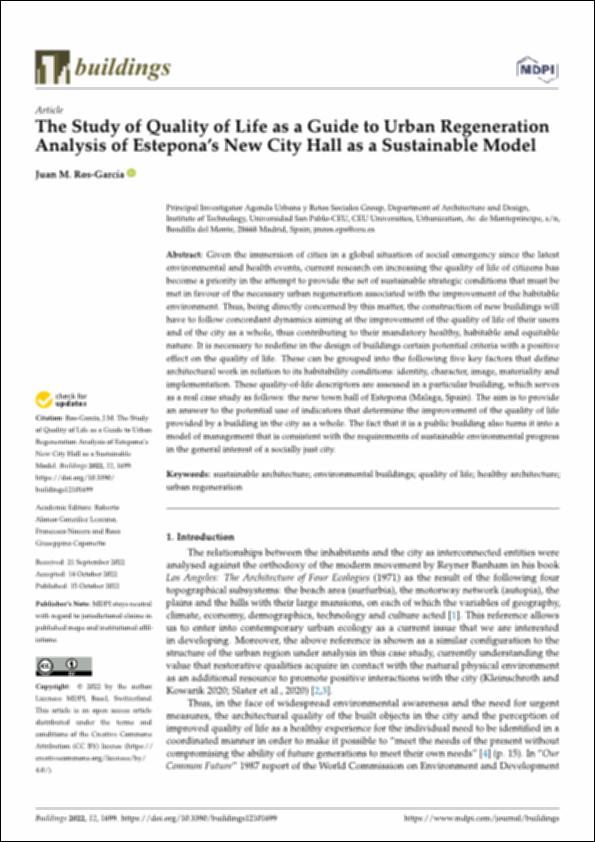Please use this identifier to cite or link to this item:
http://hdl.handle.net/10637/15785The Study of Quality of Life as a Guide to Urban Regeneration Analysis of Estepona’s New City Hall as a Sustainable Model
| Title: | The Study of Quality of Life as a Guide to Urban Regeneration Analysis of Estepona’s New City Hall as a Sustainable Model |
| Authors : | Ros García, Juan Manuel |
| Keywords: | Sustainable architecture; Environmental buildings; Healthy architecture |
| Publisher: | MDPI |
| Citation: | Ros-García, J.M. The Study of Quality of Life as a Guide to Urban Regeneration Analysis of Estepona’s New City Hall as a Sustainable Model. Buildings 2022, 12, 1699. https://doi.org/10.3390/ buildings12101699 |
| Abstract: | Given the immersion of cities in a global situation of social emergency since the latest environmental and health events, current research on increasing the quality of life of citizens has become a priority in the attempt to provide the set of sustainable strategic conditions that must be met in favour of the necessary urban regeneration associated with the improvement of the habitable environment. Thus, being directly concerned by this matter, the construction of new buildings will have to follow concordant dynamics aiming at the improvement of the quality of life of their users and of the city as a whole, thus contributing to their mandatory healthy, habitable and equitable nature. It is necessary to redefine in the design of buildings certain potential criteria with a positive effect on the quality of life. These can be grouped into the following five key factors that define architectural work in relation to its habitability conditions: identity, character, image, materiality and implementation. These quality-of-life descriptors are assessed in a particular building, which serves as a real case study as follows: the new town hall of Estepona (Malaga, Spain). The aim is to provide an answer to the potential use of indicators that determine the improvement of the quality of life provided by a building in the city as a whole. The fact that it is a public building also turns it into a model of management that is consistent with the requirements of sustainable environmental progress in the general interest of a socially just city. |
| URI: | http://hdl.handle.net/10637/15785 |
| Rights : | http://creativecommons.org/licenses/by-nc-nd/4.0/deed.es Open Access |
| ISSN: | 2075-5309 |
| Issue Date: | 15-Oct-2022 |
| Center : | Universidad San Pablo-CEU |
| Appears in Collections: | Escuela de Politécnica Superior |
Items in DSpace are protected by copyright, with all rights reserved, unless otherwise indicated.


